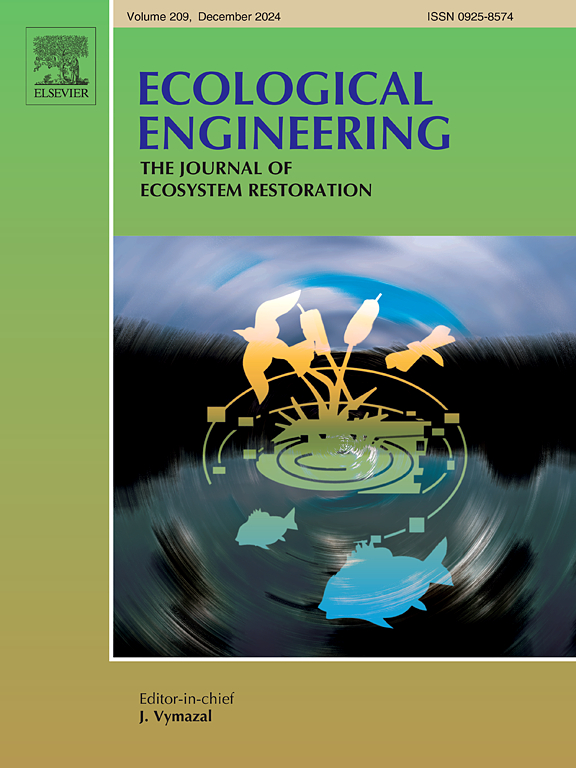Meta-analysis of mangrove phytoremediation for heavy metal mitigation in coastal regions of China
IF 4.1
2区 环境科学与生态学
Q1 ECOLOGY
引用次数: 0
Abstract
Heavy metals (HMs) are major contributors to coastal pollution and pose serious threats to coastal biodiversity. Given their non-degradability, bio-accumulation, bio magnification, abundance, and toxicity through successive trophic levels, effective management strategies are crucial to addressing toxic metals. Recently, mangrove forestation regions in China have faced increasing HM pollution. This meta-analysis evaluates phytoremediation strategies employed by various mangrove species against toxic metals and organic pollutants in different provinces of China. Data on the phytoremediation potential of mangroves were collected and analyzed from 220 publications within 24 years, from 2000 to 2024. Results indicate a 28 % increase in phytoremediation potential in China. Notably, significant phytoremediation was observed in Bruguiera sexangula (33 %) in Hainan, Kandelia abovata in Guangdong (27 %), Zhejiang (25 %), Liaoning (26 %), and Tianjin (6 %), Avicennia marina in Shandong (22 %); Sonneratia apetala (3 %) in Jiangsu, Bruguiera gymnorhiza in Fujian (9 %) and Rhizophora stylosa (6 %) in Guangxi province. Additionally, significant accumulation of HMs was observed in sediments (5 μg/g), plant parts (3–20 μg/g), and soil (7 μg/g). Our study demonstrated that K. obovata, B. sexangula, A. marina, B.gymnorhiza, R. stylosa, and S. apetala showed morphological changes such as pneumatophores and viviparous propagules, biochemical changes (e.g., increased antioxidants, such as MDA, PPO, SKDH, CAD) and genetic changes, (e.g., upregulation of antioxidant genes) in response to the toxic effects of HMs. Furthermore, Igeo, PLI, and ERI values reveal that Guangdong, Shandong, Jiangsu, Zhejiang, and Tianjin would be considered polluted regions (Igeo >6; PLI < 1; ERI > 1).

中国沿海地区红树林植物修复对重金属缓解的meta分析
重金属是海岸带污染的主要来源,对海岸带生物多样性构成严重威胁。考虑到它们的不可降解性、生物积累、生物放大、丰度和通过连续营养水平的毒性,有效的管理策略对解决有毒金属至关重要。近年来,中国红树林区的HM污染日益严重。本荟萃分析评估了中国不同省份不同红树林物种对有毒金属和有机污染物的植物修复策略。从2000年到2024年的24年间,从220份出版物中收集和分析了红树林植物修复潜力的数据。结果表明,中国的植物修复潜力增加了28%。值得注意的是,海南(33%)、广东(27%)、浙江(25%)、辽宁(26%)、天津(6%)、山东(22%)的植物修复效果显著;江苏无瓣海桑(3%),福建褐皮草(9%),广西茎尖根草(6%)。此外,在沉积物(5 μg/g)、植物部位(3 ~ 20 μg/g)和土壤(7 μg/g)中均观察到显著的HMs积累。我们的研究表明,在HMs的毒性作用下,obovata、B. sexangula、A. marina、B.gymnorhiza、R. stylosa和S. aptala表现出形态变化(如肺细胞和胎生繁殖体)、生化变化(如MDA、PPO、SKDH、CAD等抗氧化剂增加)和遗传变化(如抗氧化基因上调)。此外,Igeo、PLI和ERI值显示,广东、山东、江苏、浙江和天津将被视为污染地区(Igeo >6;PLI & lt;1;ERI祝辞1).
本文章由计算机程序翻译,如有差异,请以英文原文为准。
求助全文
约1分钟内获得全文
求助全文
来源期刊

Ecological Engineering
环境科学-工程:环境
CiteScore
8.00
自引率
5.30%
发文量
293
审稿时长
57 days
期刊介绍:
Ecological engineering has been defined as the design of ecosystems for the mutual benefit of humans and nature. The journal is meant for ecologists who, because of their research interests or occupation, are involved in designing, monitoring, or restoring ecosystems, and can serve as a bridge between ecologists and engineers.
Specific topics covered in the journal include: habitat reconstruction; ecotechnology; synthetic ecology; bioengineering; restoration ecology; ecology conservation; ecosystem rehabilitation; stream and river restoration; reclamation ecology; non-renewable resource conservation. Descriptions of specific applications of ecological engineering are acceptable only when situated within context of adding novelty to current research and emphasizing ecosystem restoration. We do not accept purely descriptive reports on ecosystem structures (such as vegetation surveys), purely physical assessment of materials that can be used for ecological restoration, small-model studies carried out in the laboratory or greenhouse with artificial (waste)water or crop studies, or case studies on conventional wastewater treatment and eutrophication that do not offer an ecosystem restoration approach within the paper.
 求助内容:
求助内容: 应助结果提醒方式:
应助结果提醒方式:


